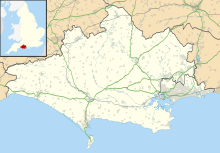The Tank Museum

Museum logo
|
|
| Established | 1947 |
|---|---|
| Location | Bovington, Dorset England |
| Coordinates | 50°41′43″N 2°14′37″W / 50.695194°N 2.243611°W |
| Type | Military Museum |
| Public transit access | Wool railway station |
| Website | www.tankmuseum.org |
The Tank Museum (previously The Bovington Tank Museum) is a collection of armoured fighting vehicles at Bovington Camp in Dorset, South West England. It is about 1 mile (1.6 km) north of the village of Wool and 12 miles (19 km) west of the major port of Poole. The collection traces the history of the tank. With almost 300 vehicles on exhibition from 26 countries it is the largest collection of tanks and the third largest collection of armoured vehicles in the world. It includes Tiger 131, the only working example of a German Tiger I tank and a British First World War Mark I, the world's oldest surviving combat tank.
It is the museum of the Royal Tank Regiment, Royal Armoured Corps and a registered charity. Bovington Camp, in which the museum is located, trains most sections of the British Army in tracked-vehicle driving as well as repairing and maintaining the vehicles in its workshops.
In 1916 the British War Office established the Bovington camp as a tank crew training facility. At that time the army was introducing tanks into the First World War in an attempt to break the stagnation of trench warfare. In 1919 the tanks returned to Bovington from France. Many of them were fit only for scrap. However, a small number of the least damaged vehicles were put to one side so that tank crews and designers could have an idea of the tank's early heritage.
In 1923 the writer Rudyard Kipling visited Bovington and recommended a museum should be set up. The collection grew greatly after the Second World War, as many Allied and captured Axis tanks were added. In 1947 it was opened to the general public. The Tank Museum has continued to expand and today it is primarily seen as a means of educating and entertaining the general public, with the exhibition being geared in this direction. Many of the tanks are in complete working order and can be seen in action throughout summer months in special displays.
...
Wikipedia

